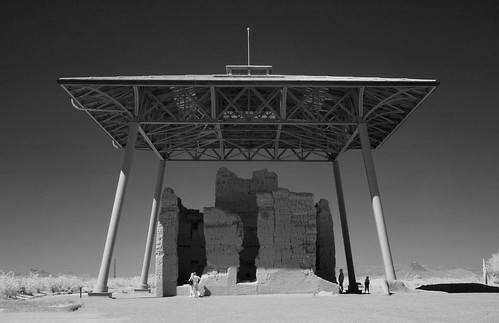This shot, Happy Landings, of a hummingbird, took approximately 40 shots to get one good one. For most of the snaps, the hummingbird was either out of the frame, the wings looked funny, or was at an angle that wasn't quite right. Luckily, I had the leisure to just stand in one place for a while, shooting when it seemed right, moving to another spot to do a few more, etc.
To set up the shot, I knew I wanted a fast shutter speed (1/500) to best capture him. Faster than this, I probably wouldn't have had enough light in this spot under the umbrella of tree leaves and I wouldn't have been able to "stop" him but still get a sense of motion in the wings. I wanted to blur the background, because the hummingbird was the main event, not the leaves behind him, so I used a large aperture (f 5.6). I let the camera choose the ISO, 3200 in this case. I used the maximum zoom on my lens of 200 mm and used a 1.4x teleconverter. I would have liked to have been closer, but I seemed to scare them away at closer distances.
I shot this at the Boyce-Thompson Arboretum, Superior, Arizona (about an hour northeast of Phoenix). It's part of the Arizona State Park System and the University of Arizona.
Want some hummingbird trivia? They are among the smallest of birds and the only ones that can fly backwards. Like bees they get nectar from flowers, but need to eat insects to get enough protein. They have the highest metabolism of all animals and their heart rate is 1250 beats per minute and their wings beat about 3,000 times per minute. Their nests are held together with spider silk and although most don't make it past the first year, they can live up to a decade.
Thursday, April 22, 2010
Patience is a Virtue
Friday, April 9, 2010
The oddest national park site I've ever been to...

Alien Landing?, originally uploaded by Cocoabiscuit.
Casa Grande National Monument* is what's left of the ruins of a Hohokam village from about the 14th century. It is rumored to be the largest prehistoric (our history at least) building in North America. "Discovered" by Spanish explorers in the late 17th century and again by American archeologists in the late 19th century. Graffiti from several centuries of adventurers is carved on its walls (and it is now illegal to add your signature). In 1932, someone decided that it needed a roof to protect it from the elements, despite having survived 7 centuries without one. The roof is termed a "Ramada" and was built by the Civilian Construction Corps. It sits on a one mile square parcel of land set aside by presidential decree in the town of Coolidge, Arizona. (The town of Casa Grande is some miles east.) The structure is visible from miles as you approach the town.
This shot was with a Nikon D70, converted for infrared, f16, 1/320 sec, 45 mm.
*National parks are by act of Congress, while national monuments are by presidential executive order.
Subscribe to:
Posts (Atom)


